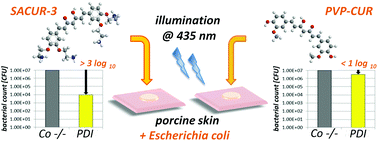A comparative study on the antibacterial photodynamic efficiency of a curcumin derivative and a formulation on a porcine skin model
Abstract
Introduction: The propagation of pathogens resistant to antibiotics around the globe has induced an urgent call for action: alternatives to conventional antibiotic therapy have to be developed to prevent a post-antibiotic catastrophe. This study focuses on the enhancement of Photodynamic Inactivation (PDI) of Gram(+) versus Gram(−) bacteria comparing a cationic derivative of curcumin (SACUR-3) to curcumin bound to polyvinylpyrrolidone (PVP-CUR) using an ex vivo porcine skin model to simulate an application on the human skin and foodstuff. Experimental: Porcine skin samples were inoculated with either Staphylococcus aureus or Escherichia coli and treated with either SACUR-3 or PVP-CUR at concentrations of 50 or 100 μM, respectively. Subsequent to blue light illumination (435 nm, 33.8 J cm−2) quantitative analyses were performed by counting the colony forming units. Furthermore, the localization of both photoactive compounds in the porcine skin was determined by fluorescence microscopy. PDI of S. aureus resulted in a reduction of 2.2 log10 steps if employing 50 μM of SACUR-3 and of 1.7 log10 steps with 50 μM of PVP-CUR. Phototoxicity towards E. coli was 3.3 log10 steps using 100 μM of SACUR-3 and 0.3 log10 steps for 100 μM of PVP-CUR. Both compounds do not exceed the stratum corneum of the skin. Conclusion: A direct comparison of both approaches yields that the cationic curcumin derivative SACUR-3 is effective against Gram(+) and Gram(−) pathogens, whereas the formulation of PVP-CUR has a photokilling effect on the Gram(+) model strain only, but leaves the approval of curcumin as a food additive E100 unaffected. Our results suggest the applicability of SACUR-3-based PDI in dermatology, hand hygiene and food production.


 Please wait while we load your content...
Please wait while we load your content...